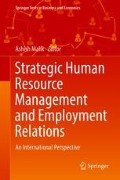Abstract
At the end of this chapter, you should be able to:
-
Analyse the key elements impacting individual level performance
-
Analyse the key elements impacting systems level performance
-
Evaluate the effectiveness of performance management systems
-
Explain the causes of poor performance at individual and systems level
Access this chapter
Tax calculation will be finalised at checkout
Purchases are for personal use only
Bibliography
Boselie, P. (2010). Strategic human resource management: A balanced approach. London: Tata McGraw-Hill Education.
Boxall, P., & Purcell, J. (2011). Strategy and human resource management. Basingstoke: Palgrave Macmillan.
Huselid, M. A. (1995). The impact of human resource management practices on turnover, productivity, and corporate financial performance. Academy of Management Journal, 38(3), 635–672.
Locke, E. A., & Latham, G. P. (1990). A theory of goal setting and task performance. Englewood Cliffs: Prentice Hall.
Shields, J. (2007). Managing employee performance and reward: Concepts, practices, strategies. Melbourne: Cambridge University Press.
West, M. A., Borrill, C., Dawson, J., Scully, J., Carter, M., Anelay, S., Patterson, M., & Waring, J. (2002). The link between the management of employees and patient mortality in acute hospitals. International Journal of Human Resource Management, 13(8), 1299–1310.
Author information
Authors and Affiliations
Corresponding author
Editor information
Editors and Affiliations
Key Questions and Learning Activities
Key Questions and Learning Activities
-
Question. 1 From your study of organisational behaviour, critically evaluate the contribution of any two theories that are relevant to the study and practice of performance management.
-
Question. 2 Critically evaluate the contribution of HRM-performance link in the wider literature on SHRM & ER.
-
Question. 3 Compare performance appraisal system from multisource performance feedback approaches.
Learning Activity: Daily Performance Monitoring at XYZ Call Centre
At XYZ Call Centre in Somewhereland country, a number of call centre agents are considering quitting en-masse due to the incessant pressure that call barging and micro-managing brings for them on a daily basis. For example, call centre agents’ length of the call, tone of the call and the quality of the product information disseminated forms part of such daily monitoring. The performance of the process is evaluated on a number of rating scale parameters. Managers at XYZ highlight that the requirement of daily and excessive monitoring is part of the clients’ contractual requirements. They have to identify errors and provide a Six Sigma process report on weekly basis to the clients with details of corrective action taken. The organisation currently has an annual employee turnover of 80% and its hiring managers are always fulfilling new hire demands. If you were the HR manager at XYZ Call Centre, what solution(s) would like to propose to rectify this situation?
Glossary
- High performance work practices
-
is a ‘set’ or a ‘bundle’ of HRM practices, which, if implemented collectively can be the source of sustained competitive advantage to firms. Even though there is extensive research on this topic, consensus is far from being reached in terms of the ‘set’ or ‘bundle’ of HRM practices that are central to high performance.
- Performance Appraisal
-
is a process that involves planning, observing, measuring and evaluating an individual’s performance against a set of performance expectations using a set criteria.
- Performance Management
-
is a holistic process that focuses on linking an individual’s goals to an organisation’s overall strategic direction and scope. The process involves goal-setting, development, reward, appraisal and ongoing mentoring and coaching using formal and informal mechanisms including the use of single and multiple feedback systems such as 360-degree feedback systems.
Rights and permissions
Copyright information
© 2018 Springer Nature Singapore Pte Ltd.
About this chapter
Cite this chapter
Malik, A. (2018). Strategic Performance and Commitment Management. In: Malik, A. (eds) Strategic Human Resource Management and Employment Relations. Springer Texts in Business and Economics. Springer, Singapore. https://doi.org/10.1007/978-981-13-0399-9_9
Download citation
DOI: https://doi.org/10.1007/978-981-13-0399-9_9
Published:
Publisher Name: Springer, Singapore
Print ISBN: 978-981-13-0398-2
Online ISBN: 978-981-13-0399-9
eBook Packages: Business and ManagementBusiness and Management (R0)

